                  
|

NEWSLETTER - January 2018 |
|
|
|
|
|
|
Sikkim has been given many names. The Lepchas,
original inhabitants of the land called it Nye-mae-el `paradise'.
The Limbus named it Su Khim or `new house' while to the Bhutias it
was Beymul Demazong `the hidden valley of rice'.
Today, travelers embarking on a journey of Sikkim discover a
mystical wonderland of spectacular natural beauty. The panoramic
perfection of the snow-capped Himalayas, the heady scent of
flower-bedecked meadows, the vibrant culture and joyous festivals,
the infinite variety of its flora and fauna makes it a holiday
that is at once fascinating and challenging.
This month we bring to you Sikkim as the destination of the
month.
Look forward to receiving your views and feedback on our
efforts to update you with the latest from India.
Wishing you all a wonderful 2018!
GITA - India Unveiled! |
|
|
|
90-room Zone by The Park, Jodhpur
opens doors
The Park Hotels enters Jodhpur with the launch of its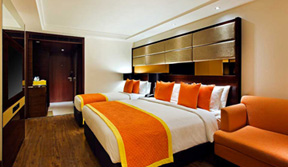 second hotel in Rajasthan – ‘Zone by The Park’. With 90 guest
rooms, the latest Zone by The Park Jodhpur is located at the city
centre in close proximity to popular tourist destinations such as
Umaid Bhawan Palace and scenic Kalyana Lake. The city airport and
railway station are minutes away from the hotel making it
convenient for the guests. Zone Jodhpur boasts of 7,600 sq. ft.
banquet hall with a spill over 14,000 sq. ft. outdoor lawn for
large weddings, exhibitions, social gatherings, celebrations and
conferences. The hotel has two restaurants and a discotheque.
second hotel in Rajasthan – ‘Zone by The Park’. With 90 guest
rooms, the latest Zone by The Park Jodhpur is located at the city
centre in close proximity to popular tourist destinations such as
Umaid Bhawan Palace and scenic Kalyana Lake. The city airport and
railway station are minutes away from the hotel making it
convenient for the guests. Zone Jodhpur boasts of 7,600 sq. ft.
banquet hall with a spill over 14,000 sq. ft. outdoor lawn for
large weddings, exhibitions, social gatherings, celebrations and
conferences. The hotel has two restaurants and a discotheque.
The hotel is designed to meet the requirements of the
price-conscious, design-conscious urban traveller.
The Oberoi, New Delhi reopens after
a two-year of renovation
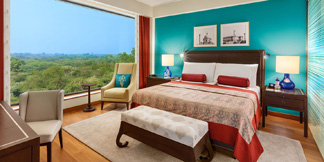 The
Oberoi, New Delhi reopens after an extensive renovation of two
years. The interiors of the hotel have been redone including the
refurbishment of its soft furnishings. The hotel is open for
reservations and the basic room category is available from Rs.
18,000 onward. Despite being contemporary, the hotel has managed
to retain the essence of heritage within its premises. The
Oberoi, New Delhi reopens after an extensive renovation of two
years. The interiors of the hotel have been redone including the
refurbishment of its soft furnishings. The hotel is open for
reservations and the basic room category is available from Rs.
18,000 onward. Despite being contemporary, the hotel has managed
to retain the essence of heritage within its premises.
41-room Clarks Inn debuts in Srinagar, Kashmir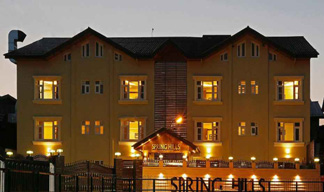
Clarks Inn Group of Hotels has added another feather to its
growing portfolio with the opening of Clarks Inn Srinagar. The
41-room property is strategically located at a stone-throw
distance from the commercial hub of Lal Chowk and Srinagar’s
scenic Dal Lake and just about three kilometres from the Mughal
Garden. Located in the city centre at Jawahar Nagar, Clarks Inn
Srinagar boasts of 41 rooms across different categories to cater
to the needs of discerning business as well as leisure travellers.
Radisson Mumbai Goregaon commences
operations
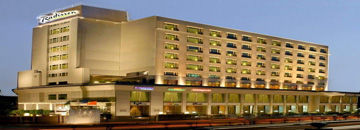 Situated
in the commercial hub of Goregaon in Mumbai, Radisson Mumbai
Goregaon recently opened its doors to the financial capital. The
hotel is surrounded by shopping districts, entertainment centers,
tourist attractions, corporate set-ups and located in proximity to
the international airport. Situated
in the commercial hub of Goregaon in Mumbai, Radisson Mumbai
Goregaon recently opened its doors to the financial capital. The
hotel is surrounded by shopping districts, entertainment centers,
tourist attractions, corporate set-ups and located in proximity to
the international airport.
Radisson Mumbai Goregaon features 98 contemporary rooms with
modern amenities. The rooms are spread across three categories
namely, superior, business class and suite. All rooms are equipped
with amenities including free Wi-Fi, 42-inch LED TV with premium
channels, and coffee and tea making facilities. With wellness as a
brand pillar, the hotel features facilities such as an in-house
spa, salon and a rooftop swimming pool.
285-room Conrad Bengaluru opens doors
Conrad Hotels & Resorts has expanded in India with the opening of
Conrad Bengaluru. The 24-storeyed hotel is owned by Prestige Group
and managed by Hilton. Featuring 285 guestrooms including 21
suites, Conrad Bengaluru offers five dining and bar experiences, a
full-service spa and salon, 17,000 square feet of event space, a
24-hour fitness centre and an outdoor temperature-controlled
infinity pool overlooking the expanse of the city as well as a
dedicated kids’ pool.
ibis Pune Hinjewadi opens doors
with 136 rooms
I nterGlobe
Hotels and AccorHotels has announced the opening of ibis Pune
Hinjewadi (IPH). The launch of ibis Pune Hinjewadi marks
AccorHotels’ third property in the city. Featuring 136
well-appointed rooms, the hotel offers unparalleled comfort and
convenience with its range of in-room amenities and signature
Sweet Bed bedding concept by ibis. To celebrate its opening, ibis
Pune Hinjewadi is offering a special price of Rs. 3,699 per night,
with breakfast for two from now until 31 March, 2018.
Strategically located within 5 km of the Mumbai-Bangalore highway,
the hotel is in close proximity to the International Biotech Park
and with various multinational corporations such as Infosys, Tech
Mahindra, Wipro, Accenture and IBM located nearby. The hotel is
situated approximately 20km from Pune Airport and the railway
station. The hotel also offers complimentary high speed Wi-Fi
access to ensure that guests can enjoy a relaxing stay. For food
aficionados, ibis Pune Hinjewadi features the signature ‘Spice It’
restaurant – a culinary concept tailor-made for India serving
Indian, Oriental and European cuisine prepared from the freshest
locally sourced ingredients. nterGlobe
Hotels and AccorHotels has announced the opening of ibis Pune
Hinjewadi (IPH). The launch of ibis Pune Hinjewadi marks
AccorHotels’ third property in the city. Featuring 136
well-appointed rooms, the hotel offers unparalleled comfort and
convenience with its range of in-room amenities and signature
Sweet Bed bedding concept by ibis. To celebrate its opening, ibis
Pune Hinjewadi is offering a special price of Rs. 3,699 per night,
with breakfast for two from now until 31 March, 2018.
Strategically located within 5 km of the Mumbai-Bangalore highway,
the hotel is in close proximity to the International Biotech Park
and with various multinational corporations such as Infosys, Tech
Mahindra, Wipro, Accenture and IBM located nearby. The hotel is
situated approximately 20km from Pune Airport and the railway
station. The hotel also offers complimentary high speed Wi-Fi
access to ensure that guests can enjoy a relaxing stay. For food
aficionados, ibis Pune Hinjewadi features the signature ‘Spice It’
restaurant – a culinary concept tailor-made for India serving
Indian, Oriental and European cuisine prepared from the freshest
locally sourced ingredients.
|
|
|
48.3% growth in FTAs on e-TV in
December y-o-y
The number of Foreign Tourist Arrivals (FTAs) in December 2017 was
11.76 lakh as compared to FTAs of 10.21 lakh in December 2016 and
9.13 lakh in December 2015. The growth rate in FTAs in December
2017 over December 2016 has increased to 15.2 per cent, compared
to 11.9 per cent in December 2016 over December 2015. FTAs in 2017
were 101.77 lakh with a growth of 15.6 per cent over 2016,
compared to FTAs of 88.04 lakh with a growth of 9.7 per cent in
2016 over 2015. The percentage share of Foreign Tourist Arrivals (FTAs)
in India during December 2017 among the top 15 source countries
was highest from Bangladesh (19.04%) followed by USA (16.90%), UK
(10.41%), Australia (5.31%), Canada (3.85%), Russian Fed. (3.79%),
Malaysia (3.11%), Germany (2.08%), China (2.06%), Sri Lanka
(2.01%), Singapore (1.85%), France (1.81%), Japan (1.64%),
Thailand (1.60%) and Italy (1.44%). The percentage share of
Foreign Tourist Arrivals (FTAs) in India during December 2017
among the top 15 ports was highest at Delhi Airport (25.80%)
followed by Mumbai Airport (17.31%), Haridaspur Land Check Post
(9.75%), Chennai Airport (6.36%), Bengaluru Airport (5.33%),
Dabolim (Goa) Airport, (5.29%), Kolkata Airport (4.95%), Cochin
Airport (3.92%), Hyderabad Airport (3.02%), Ahmadabad Airport
(2.63%), Gede Rail Land Check Post (1.94%), Trivandrum Airport,
Trichy Airport (1.44%), Ghojadanga Land Check Post (1.26%) and
Sonauli Land Check Post (1.14%).
|
|
|
Delhi-Chennai direct on Vistara from Feb 15
Vistara has announced the addition of Chennai to its expanding
network, making it the 22nd destination on the airline’s network.
Effective February 15, 2018, Vistara will operate a daily direct
flight between Delhi and Chennai, and increase the frequency to
twice daily from March 1, 2018. Vistara will also connect Chennai
to Port Blair with a daily direct flight between the two cities,
effective March 1, 2018.
SpiceJet increases flight frequencies
 SpiceJet
has increased its frequencies in existing sectors and upgraded
seat capacity on various routes across its domestic and
international network to service additional demand from growing
markets. The airline will operate a renewed winter schedule with
10 new daily frequencies added on its domestic network
encompassing some popular routes such as Chennai-Kochi (fourth
direct flight added), Bengaluru-Vijayawada (second direct flight
added) Kochi-Chennai (fourth direct flight added) and Hyderabad-Vijayawada
(second direct flight added) among others. On its international
network, SpiceJet will be reinforcing its frequencies on the
Delhi-Kabul route by increasing its operations from three days a
week to five days a week. SpiceJet
has increased its frequencies in existing sectors and upgraded
seat capacity on various routes across its domestic and
international network to service additional demand from growing
markets. The airline will operate a renewed winter schedule with
10 new daily frequencies added on its domestic network
encompassing some popular routes such as Chennai-Kochi (fourth
direct flight added), Bengaluru-Vijayawada (second direct flight
added) Kochi-Chennai (fourth direct flight added) and Hyderabad-Vijayawada
(second direct flight added) among others. On its international
network, SpiceJet will be reinforcing its frequencies on the
Delhi-Kabul route by increasing its operations from three days a
week to five days a week.
Delhi-Gorakhpur on Air India 6 times a week
Air India has announced that it will operate a new flight from New
Delhi to Gorakhpur, six days a week, starting January 15, 2016.
The flight will offer connection to flyers travelling to various
domestic
 and
international destinations from Gorakhpur. This would also offer a
convenient connection to Gorakhpur from Delhi to passengers
arriving from the Gulf and other international destinations. This
is the latest destination to be added to Air India’s network under
its Connecting India programme. India’s national carrier, also
launched operations between Mumbai and Gwalior with ATR-72
aircraft and also connected Durgapur to Delhi and Kolkata with an
A319 flight. Air India will operate a 70 seater ATR 72-600
aircraft between Delhi and Gorakhpur. The flight AI 9809 will
depart from Delhi at 1215 hrs and arrive Gorakhpur at 1415 hrs. On
the return leg, flight AI 9810 will depart from Gorakhpur at 1445
hrs and reach Delhi at 1645 hrs. The flight will operate six days
a week on Monday, Tuesday, Wednesday, Thursday, Friday and
Saturday. and
international destinations from Gorakhpur. This would also offer a
convenient connection to Gorakhpur from Delhi to passengers
arriving from the Gulf and other international destinations. This
is the latest destination to be added to Air India’s network under
its Connecting India programme. India’s national carrier, also
launched operations between Mumbai and Gwalior with ATR-72
aircraft and also connected Durgapur to Delhi and Kolkata with an
A319 flight. Air India will operate a 70 seater ATR 72-600
aircraft between Delhi and Gorakhpur. The flight AI 9809 will
depart from Delhi at 1215 hrs and arrive Gorakhpur at 1415 hrs. On
the return leg, flight AI 9810 will depart from Gorakhpur at 1445
hrs and reach Delhi at 1645 hrs. The flight will operate six days
a week on Monday, Tuesday, Wednesday, Thursday, Friday and
Saturday.
IndiGo to start direct daily to Colombo
from Chennai, Bengaluru from Jan 20
haring its operational plans from Colombo, IndiGo has announced
that Colombo will become its eighth international destination
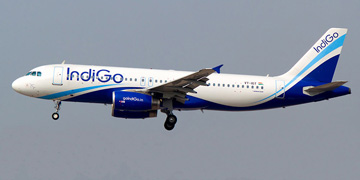 effective
January 20, 2018 with daily direct flights from Chennai and
Bengaluru. With these new flights, the airline will also offer
connections to and from Delhi, Hyderabad, Kolkata, Mumbai and
other major Indian cities. effective
January 20, 2018 with daily direct flights from Chennai and
Bengaluru. With these new flights, the airline will also offer
connections to and from Delhi, Hyderabad, Kolkata, Mumbai and
other major Indian cities.
IndiGo adds flights to Tirupati network
IndiGo has added another flight to its Tirupati network. Tirupati
will be connected by three daily non-stop flights to Hyderabad and
double daily non-stop flights to Bengaluru. Minister of Civil
Aviation, Ashok Gajapathi Raju along with Aditya Ghosh, President
and Whole Time Director, IndiGo flagged-off the second flight from
Tirupati to Hyderabad at Tirupati International Airport. Apart
from this, Tirupati will also be connected to many new cities on
IndiGo’s existing network of Airbus 320s and ATRs. IndiGo will
connect Tirupati to Delhi, Mumbai, Kolkata, Dubai, Singapore among
other cities via Bengaluru, Hyderabad, Chennai and Mangalore.
Ural Airlines to start flights between India and
Russia
The potential of the outbound tourist market from India to Russia
has
 prompted
Ural Airlines to start flights from various cities in India ex
Yekaterinburg to Moscow, St. Petersburg, and to the other cities
in Russia along with offering connections to other prime
destinations in Europe. As per the Russian Information Centre (RIC),
tourists from India to Russia have been growing at 30 per cent YoY.
Considering the unique needs of Indian tourists and to cater to
their specific needs, Ural Airlines is considering to join the
‘India-Friendly’ programme in Russia, which is initiated and
executed by RIC in India. Airports of Regions & Russian
Information Center in India are assisting the process of launch of
services in India by helping identify partners and other
associates that will contribute to the entry of Ural Airlines into
the India market. Ural Airlines is the primary airline of Airport
Koltsovo in Yekaterinburg and one of the largest rapidly
developing Russian airlines. prompted
Ural Airlines to start flights from various cities in India ex
Yekaterinburg to Moscow, St. Petersburg, and to the other cities
in Russia along with offering connections to other prime
destinations in Europe. As per the Russian Information Centre (RIC),
tourists from India to Russia have been growing at 30 per cent YoY.
Considering the unique needs of Indian tourists and to cater to
their specific needs, Ural Airlines is considering to join the
‘India-Friendly’ programme in Russia, which is initiated and
executed by RIC in India. Airports of Regions & Russian
Information Center in India are assisting the process of launch of
services in India by helping identify partners and other
associates that will contribute to the entry of Ural Airlines into
the India market. Ural Airlines is the primary airline of Airport
Koltsovo in Yekaterinburg and one of the largest rapidly
developing Russian airlines.
|
|
Sikkim
The crowning glory of Sikkim is Mt. Khangchendzonga, the
third highest mountain in the world. With magnificent snow and ice
scenery it is often regarded as the undisputed monarch among the
peaks of the world. But for the Sikkimese Khangchendzonga is much
more than a mountain and is revered as the abode of their guardian
deity Dzo-nga.
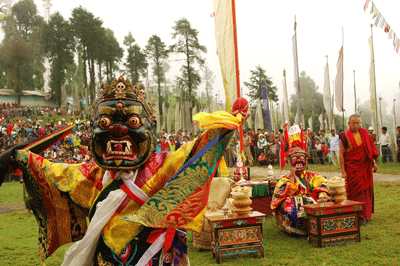 Even today the mountain god is invoked and prayed to during Pang
Lhabsol, a major Sikkimese festival, which also commemorates the
blood brotherhood sworn between the Lepchas and the Bhutias at
Kabi in the fifteenth century. The sacred mountain can be viewed
from every corner of Sikkim and remains an intrinsic part of the
consciousness of the people. Even today the mountain god is invoked and prayed to during Pang
Lhabsol, a major Sikkimese festival, which also commemorates the
blood brotherhood sworn between the Lepchas and the Bhutias at
Kabi in the fifteenth century. The sacred mountain can be viewed
from every corner of Sikkim and remains an intrinsic part of the
consciousness of the people.
Sikkim shares its border with Nepal in the west and Bhutan in the
east, with the Tibetan plateau rising from its northern border. It
was once a Himalayan monarchy and part of the fabled Silk Route to
China. Its merger with India in 1975 has offered a window to the
world to discover the treasures of this hidden land.
Sikkim has much to offer all her visitors. From popular home stays
where one can get a first hand experience of rural Sikkim to
endless possibilities for adventure sports. From ancient
monasteries and flamboyant festivals to all the amenities of the
modern world. The State is naturally gifted having all sorts of
destinations and circuits required for the tourists. Tourism in
Sikkim has impressive varieties of Tourism Products, some of them
are: Organic, Green and Pollution Free State, Very rich Culture,
traditions, heritage and strong commitment, Eco-tourism &
Wildlife, Village Tourism, Adventure Tourism, Wellness, Health,
Yoga, Herbal and medical tourism, Religious, culture, Heritage and
pilgrimage Tourism, Conference Tourism and many more.
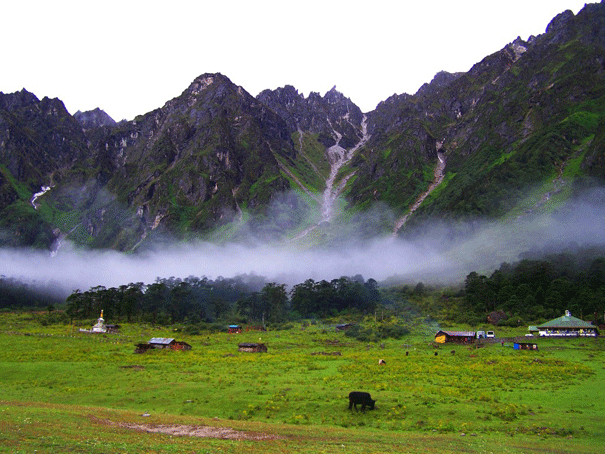 The mighty and majestic mountains, green valleys, wilderness &
sense of adventure, delightful cuisines, peaceful and crime free
State, Hot spot of biodiversity and a mixture of things that would
make any place on the earth a delight to visit, has made Sikkim
the hot destination for Tourism that it should be. Virtually
unexplored, offers unique opportunities in almost all the major
aspects of Tourism. The mighty and majestic mountains, green valleys, wilderness &
sense of adventure, delightful cuisines, peaceful and crime free
State, Hot spot of biodiversity and a mixture of things that would
make any place on the earth a delight to visit, has made Sikkim
the hot destination for Tourism that it should be. Virtually
unexplored, offers unique opportunities in almost all the major
aspects of Tourism.
People & Culture
The People of Sikkim consist of three ethnic groups, that is,
Lepcha, Bhutia and Nepali. Communities of different hues
intermingle freely in Sikkim to constitute a homogenous blend.
Hindu Temples coexist with Buddhist Monasteries, Churches, Mosque
and Gurudwara. The predominant Communities are Lepchas, Bhutias
and Nepalese. These myriad Cultures has produced a quintessential
Sikkimese Culture that encompasses all ways and walk of life, but
has also managed to preserve their own identity. These can also be
seen in the various places of Worship, Festivals and Cultural
dances that are celebrated through the year.
Pilgrimage Tourism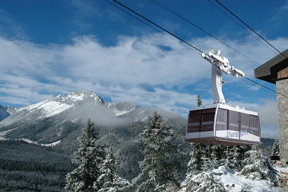
Shiva Mandir, Legship : Also known as Kirateshwar Mahadev temple,
it is situated on the banks of beautiful Rangit river. A foot
suspension bridge takes the devotees to its attractive location.
People from all over the state visit this holy place of eminence.
According to popular belief, whosoever worships here will earn
virtues of two life times.
Heritage Tourism
Dubdi Monastery : This was the first monastery established
soon after the consecration ceremony of the first Chogyal. The
monastery is located on a hill top above Yuksom surrounded by
verdant forest. It can be approached by trekking only, negotiating
steep slope for about half an hour. It is an ideal place for lamas
seeking meditation recluse..
Pemayangste Monastery : It is one of the oldest monasteries
of the State. It was originally established by Lhatsun
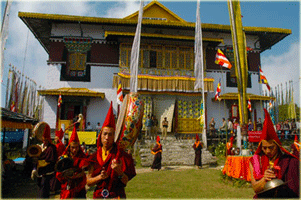 Chempo, one
of the revered Lamas to have performed the consecration ceremony
of the first Chogyal (Monarch) of Sikkim. This ancient monastery
belonging to the Nyingma Sect has been considered as one of the
premier monasteries in the State. It has been entrusted with the
task to perform all religious functions of the erstwhile monarch. Chempo, one
of the revered Lamas to have performed the consecration ceremony
of the first Chogyal (Monarch) of Sikkim. This ancient monastery
belonging to the Nyingma Sect has been considered as one of the
premier monasteries in the State. It has been entrusted with the
task to perform all religious functions of the erstwhile monarch.
Originally, it was established as a high class monastery for "Pure
Monks (Ta-Sang). Inside the monastery there is a wooden structure
depicting the Maha Guru's heavenly palace (Sang-tok-palri), which
is considered a masterpiece created by Dungzin Rimpoche. The
Monastery, located on a hill top at an altitude of 6300 ft.
commands a magnificent panoramic view of the Himalayan ranges, the
surrounding hills and the countryside. A well furnished PWD Guest
House is located just across the Monastery on a small hill top.
Tashiding : Tashiding, the most holy of all monasteries in
Sikkim was built in
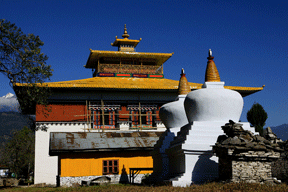 1716 on the spot consecrated by Guru Rimpoche.
According to legend Guru Rimpoche shot an arrow and vowed to
meditate where it fell. The arrow dropped on the spot where the
monastery now stands. Located on a hill top between the rivers
Ratong and Rangeet it is surrounded by deep valleys. Tashiding
also has the famous chorten Thongwa Rangdol built by Lhatsun
Chenpo and considered the most holy in Sikkim. It is believed that
a glimpse of this chorten is enough to cleanse one of a lifetime
of sin. 1716 on the spot consecrated by Guru Rimpoche.
According to legend Guru Rimpoche shot an arrow and vowed to
meditate where it fell. The arrow dropped on the spot where the
monastery now stands. Located on a hill top between the rivers
Ratong and Rangeet it is surrounded by deep valleys. Tashiding
also has the famous chorten Thongwa Rangdol built by Lhatsun
Chenpo and considered the most holy in Sikkim. It is believed that
a glimpse of this chorten is enough to cleanse one of a lifetime
of sin.
The monastery is also the venue for the annual Bumchu festival
which divines the fortune of the coming year for Sikkim.
Rumtek :Located on a hill facing Gangtok and 24 kms from
here, the original Rumtek monastery was built by the fourth
Chogyal. This was damaged by an earthquake and has been rebuilt.
The new Rumtek monastery was built by the 16th Gyalwa Karmapa. It
is the largest in Sikkim and reflects the best of Tibetan
architecture. It is also a treasure trove of some of the most
unique religious objects found anywhere in the world, apart from
also being a world-renowned centre of Kagyu teachings. Rumtek
monastery is the seat of the Kargyupa sect of Buddhism and an
almost replica of the Kagyu headquarters in Tsurphu [Tibet].
The old Rumtek monastery celebrates its annual chaam along with
Ralong and Phodong two days prior to Losoong [Sikkimese New Year]
Village Tourism : The UNESCO Project for the Development of
Cultural Tourism and Ecotourism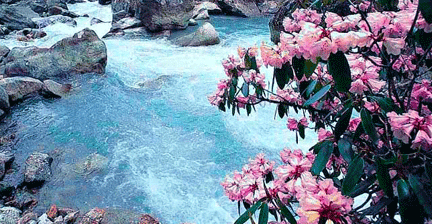 in the Mountainous Regions of
Central and South Asia is sponsored by the Norwegian Government
with the support of the Principality of Andorra. The project aims
to promote cooperation between local communities, national and
international NGOs, and tour agencies in order to involve local
populations fully in the employment opportunities and
income-generating activities that tourism can bring. in the Mountainous Regions of
Central and South Asia is sponsored by the Norwegian Government
with the support of the Principality of Andorra. The project aims
to promote cooperation between local communities, national and
international NGOs, and tour agencies in order to involve local
populations fully in the employment opportunities and
income-generating activities that tourism can bring.
Sikkim Village Tourism :The goal of Sikkim Himalayan Homestays is
to promote community based tourism while helping local communities
benefit fully from the economic opportunities of low-impact
tourism. In this way, the spectacular environmental and cultural
heritage of these areas can be protected for future generations
and tourism can develop to meet the needs of local communities.
Ecotourism and Conservation Society of Sikkim (ECOSS) works
together with local communities and UNESCO to help communities
achieve these goals. Our members are dedicated to community
self-reliance and have a mandate to achieve the goals of
sustainable development in the fields of ecotourism and
conservation.
Hot Springs : Sikkim has many hot springs known for their
therapeutic value. High in Sulphur content, the waters are
believed to have great medicinal properties with the average
temperature of the water in these hot springs close to 50c.
There are some well known hot springs in North Sikkim. The
Yumthang Hot Spring is located some distance away from Yumthang
village. To reach the hot spring one has to walk a few hundred
yards from the road and across a pedestrian
 bridge on the River Lachung. For the convenience of bathers, there is a hut with two
pools which contains hot spring water. Hot water rich in
sulphuretted hydrogen gas from a spring just behind the hut and is
diverted to the pools. bridge on the River Lachung. For the convenience of bathers, there is a hut with two
pools which contains hot spring water. Hot water rich in
sulphuretted hydrogen gas from a spring just behind the hut and is
diverted to the pools.
A 25 kilometre drive up from Yumthang takes you to the Yume
Samdong Hot Spring at the base of the Donkia-la Pass.
Holy Caves : The mountainsides are dotted with many caves
which are considered holy by the people and revered as places of
pilgrimage. It is believed that Guru Rimpoche and Lhatsun Chenpo
have halted and meditated in these caves. Most of these caves are
located in remote places requiring tough treks.
Sikkim Holy Caves The holiest of them is Lha-ri nying phu or the
old cave on Gods hill. Located in West Sikkim, it can be reached
only after a difficult 3 day trek from Tashiding.
De-chhen phu or the cave of happiness is equally inaccessible
located in the snows above Dzongri in West Sikkim.
Pe-phu, a huge cave, is located between Tendong and Maenam hills
in South Sikkim around 5 kms from Ravangla.
Khando-sang - phu or the cave of the occult fairies is one of the
easiest to reach and is located just beyond the Rishi hot springs.
Lakes : Sikkim has many beautiful lakes dotting its
landscape. Most of the lakes in Sikkim are considered
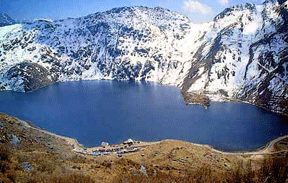 sacred and
are revered by the people. The North Sikkim plateau adjoining
Tibet has a number of mountain lakes of which Gurudongmar and Chho
Lamo are the most famous. Chho Lamo is the source of the Teesta
River. The Tsomgo Lake in East Sikkim is the most popular with
tourists while Khecheopalri in West Sikkim is one of the most
beautiful and sacred. sacred and
are revered by the people. The North Sikkim plateau adjoining
Tibet has a number of mountain lakes of which Gurudongmar and Chho
Lamo are the most famous. Chho Lamo is the source of the Teesta
River. The Tsomgo Lake in East Sikkim is the most popular with
tourists while Khecheopalri in West Sikkim is one of the most
beautiful and sacred.
Tsomgo Lake : The most visited lake in Sikkim is the Tsomgo
Lake in East Sikkim. Located 35 km from Gangtok and at an altitude
of 12,000 ft, the ethereally beautiful Tsomgo Lake is a must on
every visitors itinerary Embedded in steep and rugged mountain
terrain, the lake is covered with snow cover from early winter to
late spring. Associated with many legends and myths, Tsomgo is
regarded as holy by the Sikkimese. For the tourist a visit to the
lake offers a wonderful outing. Rides on colourfully decorated
yaks and mules are offered at the lake site, which also has a
variety of eating stalls serving snacks and beverages. Snowboots
and gumboots can be hired here. The lake also provides the perfect
backdrop for the holiday photo.
Flora : The glory of Sikkim is its breathtaking array of
flowers. Sikkims geographical positioning has gifted it a
repository of over 5000 species of flowering plants. Forests of
magnolia, blue poppies, primulas, gentians and geraniums create a
spell-binding floral spectacle. Orchids, gladioli, poppies,
azaleas and camellias add to the heady collection. Its great
variety of rhododendron ranges from shrubs at ground level to
towering specimens that set the terrain ablaze in a riot of
colours.
Orchids :Orchids are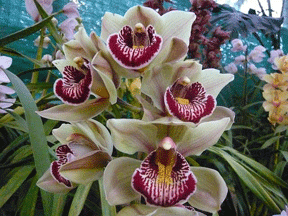 found in Sikkim, mostly in the
tropical regions up to 7000 feet elevations but some species
inhabit altitudes of 10000 feet and above. Sikkims orchids belong
to two categories: epiphyte and terrestial; the epiphytes are
better known and more numerous. The popular epiphytal orchids in
Sikkim belong to the genus Dendrobium, Cymbidium, Vanda,
Phalaenopsis, Caelogyne, Arachnanthe or Saccolabium. Of these the
Dendrobium Nobile has been adopted by the state as its official
flower. found in Sikkim, mostly in the
tropical regions up to 7000 feet elevations but some species
inhabit altitudes of 10000 feet and above. Sikkims orchids belong
to two categories: epiphyte and terrestial; the epiphytes are
better known and more numerous. The popular epiphytal orchids in
Sikkim belong to the genus Dendrobium, Cymbidium, Vanda,
Phalaenopsis, Caelogyne, Arachnanthe or Saccolabium. Of these the
Dendrobium Nobile has been adopted by the state as its official
flower.
Rhododendrons : Found in super abundance and in a riot of
colours, the rhododendron is in its full glory in Sikkim. Growing
mostly in sub-alpine and alpine regions they cover complete
hillsides in a blaze of beauty. The route to Dzongri, the
Singalila trail and the Yumthang valley in North Sikkim are
covered with rhododendron shrubs and trees. Around 30 species of
rhododendron are found in Sikkim in different sizes and shapes.
While the Rhododendron grande is over 10 m tall, the Rhododendron
nivale grows barely a few inches above the ground. Rhododendron
niveum has been declared as the State Tree of Sikkim.
Fauna : The dense forests of Sikkim are home to a variety
of animals. The Musk Deer, the munjak or the Barking Deer roam the
jungles in the upper temperate zone while the Himalayan Black Bear
is found in forests of the lower valleys to around 12,000 feet.
Also found here is the Red Panda, belonging to the raccoon family,
the Red Goral, a horned animal closely related to the Serow, the
Blue Sheep or bharal, the Shapi, belonging to the Himalayan Tahr
family and the elusive Snow Leopard, an almost mythical animal,
found in the arid cold alpine region. Another animal found mostly
in the alpine zone is the Yak. These animals are domesticated and
reared in North Sikkim and provide useful service. They are used
mainly as beasts of burden over mountain terrain and can survive
even sub-zero temperatures.
Trekking : Sikkim offers some of the finest trekking
experience in the Himalaya. The state’s vast unspoiled mountain
range is a trekker’s delight and its Barsey Rhododendron Sanctuary
passes through forests of silver fir, hemlock, magnolia and
rhododendron with a view of Kangchendzonga peaks in the
background. The Dzongri- Goecha La Trek is the most popular trek
in Sikkim and famed for great mountain views, a floral spectacle
in summer, bird and views of pristine forest.
The trek to Green Lake, the base of Mt. Kangchendzonga on the Zemu
glacier in the North Sikkim is the most enchanting of all treks in
this area with a variety of flowers such as rhododendrons,
primulas and blue poppies. Trek to this route needs a trekking
permit from Tourism Department after getting clearance from
Defense, Ministry of Home Affairs, New Delhi.
River Rafting : River rafting is the latest adventure
activity to arrive in Sikkim, and the Teesta River offers some
world class opportunities. The major route is
Makha-Sirwani-Bardang-Rongpo. Grade 2 to 4 rapids are interspersed
with placid patches to float along, and plenty of white sandy
beaches exist for overnight camping. High cliffs and gorges, along
with bolder-strewn river beds, add to the thrill. The Rangeet
River, with its more turbulent waters, also offers advanced
rafting opportunities from Sikip-Jorethang-Majitar-Melli. The best
time for rafting in Sikkim is from March to May and October to
December.
Entry Formalities to Sikkim
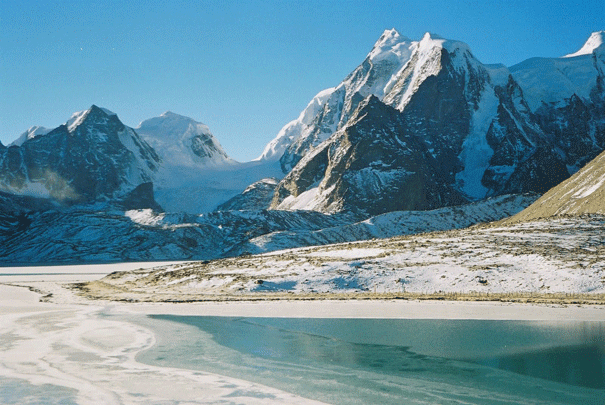 Foreigners must obtain Inner Line Permit (ILP) to visit Sikkim.
These can be obtained from all Indian Missions, Sikkim Tourism
Offices at New Delhi, Kolkata, District Magistrates Office of
Darjeeling, Siliguri, and Rangpo on the strength of an Indian
Visa. The 30 days duration Permit is issued on the spot without
any delay provided photocopies of the passport and visa along with
two pass port photos of the applicants are made available. The
permissible duration of the stay for foreign tourists is 30 days
initially. Foreigners must obtain Inner Line Permit (ILP) to visit Sikkim.
These can be obtained from all Indian Missions, Sikkim Tourism
Offices at New Delhi, Kolkata, District Magistrates Office of
Darjeeling, Siliguri, and Rangpo on the strength of an Indian
Visa. The 30 days duration Permit is issued on the spot without
any delay provided photocopies of the passport and visa along with
two pass port photos of the applicants are made available. The
permissible duration of the stay for foreign tourists is 30 days
initially.
The State Government is authorized to extend the same by a further
period of 30 days. The extension of the permit can be obtained
from FRO at Gangtok and office of Superintendent of Police of the
North, West and South Districts.
For those interested in going for trekking in the interior region
of the state, the Tourism and Civil Aviation issues Protected Area
Permit (PAP) at Gangtok which is available for certain specified
area for groups consisting of two or more foreigners subject to
condition that the trekking programme is arranged through a
registered travel agency.
Weather
When visiting Sikkim timing is crucial. Summer’s monsoon rains
hide the main attraction, those soaring mountains. The Yumthang
and Tsopta Valleys are already very cold by October and will scare
brass monkeys between December and February. Overall Sikkim’s best
season is late September to mid-November plus April and May.
|
|
                  
|
|





































